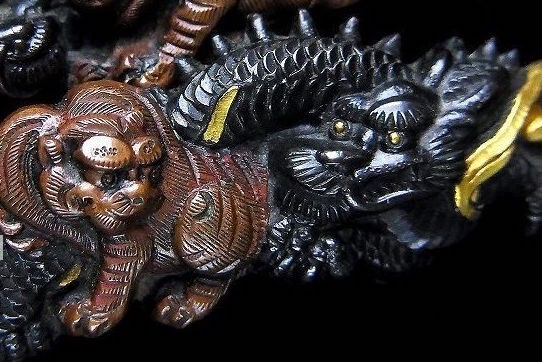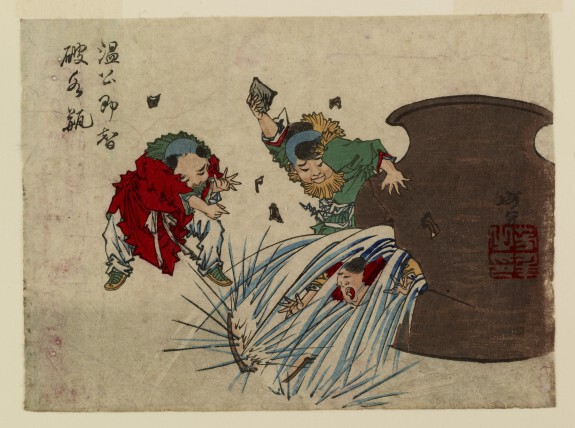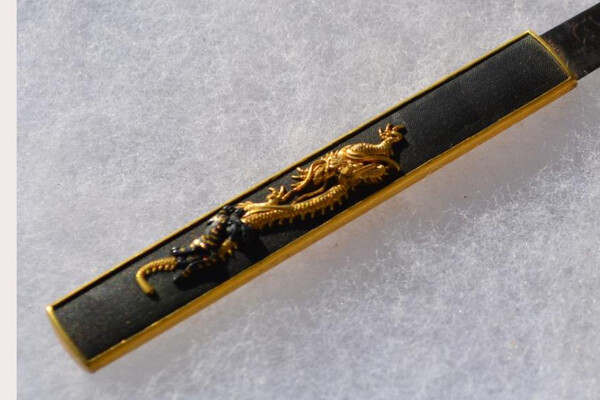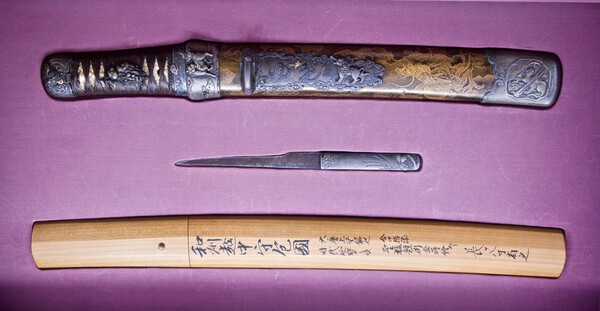-
Posts
858 -
Joined
-
Last visited
-
Days Won
7
Content Type
Profiles
Forums
Events
Store
Downloads
Gallery
Everything posted by Tanto54
-
Dear Tim, I personally like the crane & turtle approach because it ties the tosogu together in a cryptic manner (and gives you a good story to tell). Not to put words in Stephen's mouth (he has enough of his own... he's a brother Marine, so I hope he doesn't mind me talking $%*!@ about him), but I think he is trying to give you very good advice. With a little diligence you should be able to find authentic, antique kodogu for the same price as that mass produced modern stuff. In light of the expense of getting it mounted, wrapped, etc., in the long run, I think you'll be much happier. Of course, my comments about "mass produced modern stuff" does not apply to the great tosogu artists who grace the NMB (if you can ever acquire any of their work, you will be very fortunate).
-
Hi Tim, It's a rattan/bamboo bird cage (and the bird has "flown the coop"). This Tsuba certainly refers to a famous old song "Kagome Kagome" (see words below). One of the very strong clues is the shape of the weaving of the basket on your Tsuba which results in hexagonal spaces or "kagome" in Japanese. But "kagome" also has other meanings like "a caged bird". Therefore, with the birdcage, hexagonal shaped holes and fleeing bird, this Tsuba must allude to this song/theme. You can research the "Kagome Kagome" song on the Internet for its deeper meaning (Samurai, strategy, sword fighting, pregnant women, etc...) and then select other appropriate kodogu. (What's on the other side?) Kagome kagome The bird in the basket/cage, When, oh when will it come out In the night of dawn The crane and turtle slipped Who is behind you now?
-
Dear Michael, I cannot identify the theme for certain, but here are a few potential leads that you may want to consider investigating. The folktale Shita-Kiri Suzume or Tongue-Cut Sparrow mentions the happiness that a bamboo cutter experiences when he comes home each day and greets his pet sparrow at the garden gate of his house. "In the evening the old man came home. As usual, on the way back he looked forward to the time when he should reach his gate and see his pet come flying and chirping to meet him, ruffling out her feathers to show her joy, and at last coming to rest on his shoulder. But tonight the old man was very disappointed, for not even the shadow of his dear sparrow was to be seen." I believe that the shingled roof that we see on your Fuchi is the roof of a garden gate instead of the roof of a house - see how long and skinny it is? Also it has no walls - just a side pillar like a gate. Later in the tale, the sparrow flies away to his home in the bamboo forest (perhaps seen on your kashira). Alternatively, many Basho and Issa Haiku mention sparrows, bamboo and garden gates, so yours could refer to one of their more famous poems. Finally, it could simply be the common meanings for sparrow and bamboo in Japanese art (sparrow = happiness and bamboo = resilience). Let us know if you figure it out....
-
Dear Ron, I think you may be on to something when you noticed the strange number of petals (31). It's a bit of a long-shot, but the 31 petals may be a reference to Waka or Tanka poems (which have 31 syllables). You might look for a famous poem about waves and chrysanthemums.
-
I think that wearing a suit may be a good analogy. Yes, you may occasionally see someone wearing trousers and a jacket that do not match (or are not coordinated in the case of a sports jacket). However, usually the jacket and trousers are matched/coordinated and the shirt, tie, shoes and socks are also matched/coordinated. (Ken, we'll leave out you Hawaiians who occasionally wear Aloha or Luau shirts with formal jackets...) As we know, the sword was the "soul" of the Samurai, and Japanese throughout the ages have been concerned with appearance and minute attention to detail. Do you really think that a lot of Samurai (or their outfitters) just chose their kodogu for their most important symbol willy nilly? Of course, I am only referring to the better swords and koshirae - not the "bundle" swords or stuff that was cobbled together for low rent Ronin or the tourist trade (is that what you want to emulate?). Please remember that in koshirae, "matched/coordinated" does not necessarily mean the same color, metal, style, nanako, or even subject. Instead, it could be matching colors/styles with different subjects, or mismatched colors/styles with a common motif or theme (many combinations are possible). It is even possible that the Edo koshirae that Franco mentioned is actually matched/coordinated. Here's why: the dragon and phoenix are often depicted together in Japanese art (the dragon representing Water and the Phoenix or Hoo-oo Bird representing Fire). This paring is often used to symbolize wedded bliss (the combination of Fire and Water - how appropriate...) and is used on many wedding presents. If you add a kozuka with the new husband's family mon, the matched/coordinated wedding gift sword is complete. Do I know for sure? No, of course not... But I do believe that the traditional norm (not without exception) was to match/coordinate the various elements of koshirae on good swords. Much of that "coordination" is lost on those who do not know the common Japanese themes, and this has caused many sets of tosogu to be broken up since the late 1800's. Can you use mismatched/uncoordinated tosogu in putting together your koshirae? Of course... But do you really want to be "that guy" with the purple socks??? Ken, I think that our new member is seeking guidance about what is the traditional norm, not whether the norm can be broken. To further the analogy, when a youngster is getting dressed up for the first time for an important event (first job interview, etc.) and he asks how do people traditionally dress for such events. Instead of saying "you can wear whatever you want" (which is true, but is also bad/useless advice), shouldn't you put your arm around his shoulder and suggest that he might look better in a matching or coordinated suit? Otherwise, he may end up dressed in overalls, a conservative blue jacket and velvet bow tie, which wouldn't be good (unless he's an extra in the Footloose Movie....)
-
Dear Michael, I believe that the hodge-podge that Ken refers to is usually the result of uninformed collectors breaking up sets over the years or others who do not know any better putting together koshirae. In your case (mismatched fuchigashira and tsuba), if you are going to match anything with the kozuka, I think it is more common to match the kozuka to the fuchigashira.
-
Dear Nick, While the rough side of the saya is probably lacquer simulated tree bark, the "shiny" side of the saya is almost certainly actual cherry bark veneer (instead of simulated lacquer). The turtle is not a sea turtle; instead it is a freshwater softshell called a "suppon" (a Japanese delicacy). I think that Stephen is correct - the kozuka is not original. The kozuka's quality is not consistent with the other parts and the theme of the kozuka is actually Shimekazari or New Years and the rest of the koshirae is water delicacies (I believe that the fuchi depicts a fishing trap method).
-
Dear Tim, In Japanese art, a broom and pine needles often allude to Takasago and represent longevity. Jo and Uba are an old wrinkled spirit couple who sweep up the pine needles under the famous pine that is depicted in many Japanese stories and plays. They are sometimes shown together (an old man and old woman) - Uba with a broom and Jo with a rake; however, they are often represented merely by their implements. So in tosogu, you might see one menuki of a rake along with the other menuki of a broom, or a fuchi with a broom leaning against a pine tree and the kashira showing a rake. This is a common motif that samurai would have been very familiar with and is often used on presents (kimono, swords, etc.) to wish the receiver a long life. (Kanzan and Jittoku are also a possibility, and in that case, the broom would be coupled with a scroll; however, the pine needles that you mentioned point towards Takasago).
-
Dear James, Thanks for providing the better picture of your kashira. I believe that it depicts a dragon and a tiger. See the similar faces in the dragon/tiger menuki picture below. Your kashira has seen some use, so the high points are a little effaced (especially the dragon's face, but you can see his claws at the edge of the frame). As you may know, these two creatures are often paired together and are considered yin & yang - the dragon is lord of the sky and the tiger is lord of the earth.
-
Dear James, Welcome back and glad to hear you are doing better. Can you provide a "straight on" picture of the kashira? The only picture that I saw on your site was from an angle. Based on that shot, I think the kashira could be tiger and dragon. I'm fairly sure that the animal on the lower part (left side of the picture) is a tiger.
-
Dear Curran - Nice! Hope you are doing well. Happy 4th!
-
Dear Jason, The tsuba motif is Shiba Onko (Chian/Sima Qian or Sze Ma Kwang in Chinese). He was a statesman and historian of the Han Dynasty. This is a famous episode from his childhood. He and his companions were watching fish in a huge vase when one of them fell headfirst into the vase and was drowning. The rest of the the playmates ran away shrieking; however, Shiba Onko did not run and had the presence of mind to save his friend by using a rock to break the jar and drain out the water. This episode was a popular theme among Edo-period artists as a parable of intelligence and virtuous behavior. There appears to be some wear from the seppa at the edge of the seppa-dai, so this tsuba may have been mounted at one time. The commander's baton on the menuki is called a saihai.
-
Dear Barrie, I'm just guessing, but I'm fairly certain that these are not stylized bats. I've seen bats depicted in many different forms of Japanese art and have never seen them stylized in this fashion. Instead, I think each menuki has two overlapping "frames" or "cartouches" with two objects on top. I have some boating themed tosogu that show an oar, rudder and poles. They look somewhat like the objects on your menuki - do you think that is a possibility?
-
Dear Ben, My impression, for what it's worth, is that the fittings appear to be genuine (I can't tell for sure about the tsuba without having them in hand - the first bothers me around the sekigane - are they really separate pieces of metal? -and the seppadai - strange vertical scratches). Both sets appear "put together" (long ago) with mismatched parts and seppa. Most of the kodogu are lower mid-range but the saya of the second appears to me to be upper mid-range. The blades look interesting. The first Tsuba depicts two Sennin: Tekkai Sennin and Gamma Sennin. The Sennin (Tekkai) at the top is an immortal who can breathe out his spirit to allow it to go on long trips (you can faintly see the breath “marks”). Once he breathed out his spirit to allow it to visit his master on faraway Mount Hua. When his spirit returned, someone had cremated his body and scattered the ashes, requiring him to inhabit another recently deceased body. Unfortunately, the only available body was of a lame beggar, so he is often depicted in Kodogu leaning on his walking staff and breathing his soul out (sometimes shown as a small figure or a cloud). The lower figure is Gama Sennin who is always shown with a toad (sometime a three legged toad) usually climbing on his shoulder or head (on your tsuba, you can see the toad above his head between the two Sennin).
-
Dear Andrew, Your question has been posed and discussed (to death) many times here and elsewhere. Of course, that doesn't mean you don't have a right to think about it, but you should probably do some more searching and reading on your own before rehashing this theme here. As someone who has worked in Japan for many years, it seems apparent to me that you don't really have much experience in Japan or you would not hold some of the incorrect (in my opinion) assumptions about the Japanese and how they work. For the record, I believe that dedicated Westerners could pass along traditional training (originating in Japan for the first Westerner) and keep or even improve the art; however, on balance, it would be much more difficult for Westerners than the Japanese to accomplish it (for many reasons).
-
Sorry Peter, I am having a hard time understanding exactly what your point is. I'm saying that there were a very few wooden/leather lacquer covered tsuba that were actually used on swords (not many and not that it was an especially good idea). You seem to be trying to make the point that there were absolutely none that were ever used that way (and I believe that is incorrect).
-
Dear Peter, I've seen several wood/leather tsuba with signs of mounting and wear. Also, many parts of armor are wood/leather covered with lacquer and withstand rain and extensive use and wear. I had an old shinai with a lacquer covered leather tsuba that lasted for many years. I'm not saying that a wood/leather tsuba is a great idea, but I do believe that they were sometimes used.
-
Dear Franco, I'll take your wager... The rabbit in Ed's kozuka does appear that way, but without the rabbit, the dragon and tiger would be very off-center don't you think? I photoshopped it to remove the rabbit, and I think it shows that the rabbit (or at least something) was there from the beginning.
-
Dear Ed (and John), Tiger, Rabbit and Dragon together almost always stand for the Tokugawa Three: Ieyasu, Hidatada & Iemitsu. You can see a carving of this representation on the east side of the Nikkō Tōshō-gū (Pagoda at Nikko). http://blogs.yahoo.co.jp/kassy1946/52894010.html
-
- 397 replies
-
- 12
-

-
Here's a scene from Yojimbo where you can see this kind of drum in action:
-
The "tomoe mon" is on the drum (a uchiwa daiko - see below). In this case, it is not a family mon and instead refers to Kaminari - the thunder god (often used on drum heads). On the tsuba, you can see the "drumstick" next to the drum (which looks like a Western hand mirror).
-
FYI - some "Boy's Swords" (and even "Boy's Day Swords...") are good quality, smallish normal swords or wakizashi.....
-
I believe that you are correct that this is a boy's sword. As you probably know, these small swords were given to boys when they came of age or on "Boy's Day". The koshirae depicts many toys. The tsuba has a top, hobby horse, drum, bird and Sarubobo (monkey doll). The saya has a kite, Hariko Inu (paper mache toy dog), shuttlecock, and top. Fuchigashira has Hariko Inu, kite and top.
-
Hi Wayne, Military Group 4











